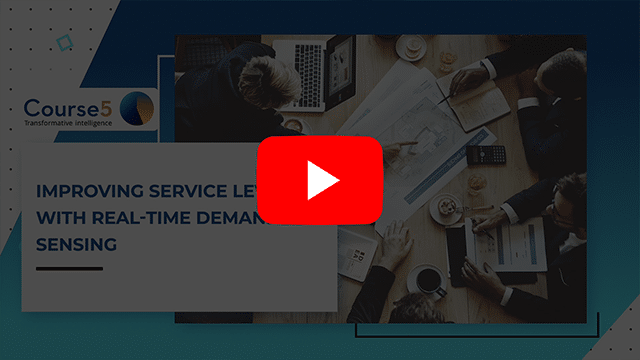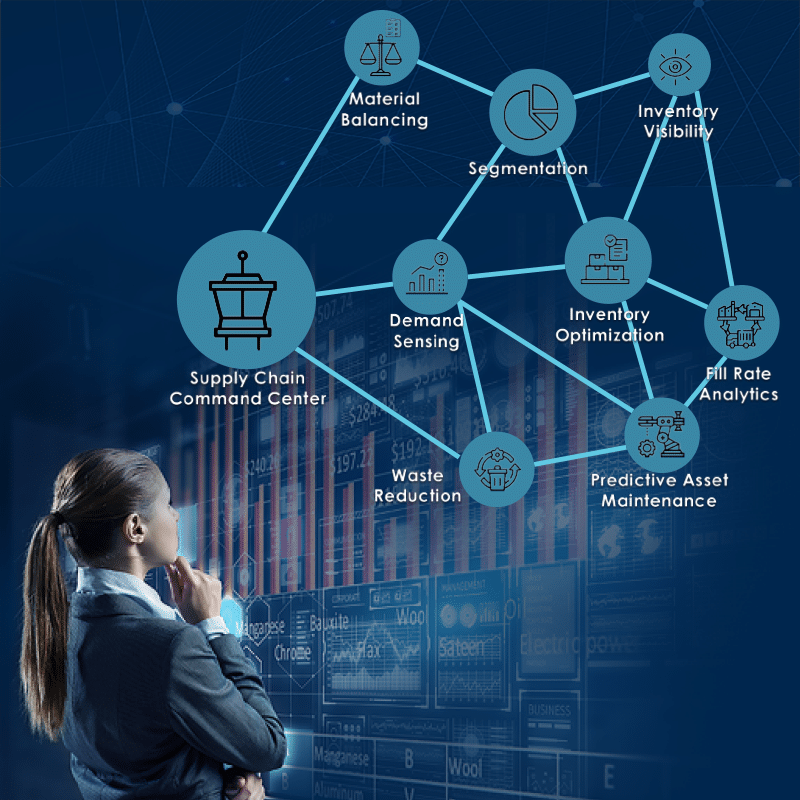Raise your demand sensing accuracy based on internal and external data with advanced algorithms. Optimize the short-term forecast by leveraging fresh sales data and probabilistic forecasting techniques. Capture the full value of demand sensing by adjusting inventory targets in a complementary manner.
How Course5’s Demand Sensing Solutions Help
Drive last-mile adoption & business impact through ease of consumption and role-based insights
Data
- Sell out
- Business inputs
- Market insights
Analytics
- Baseline statistical forecasting at the customer level
- Store clustering
Insights
- Understand demand patterns
- OoS signals
- Trade Promotion/NPI Compliance
Actions
- Field Sales Manager (FSM): Adjust store visit plan by priority
- Key Account Manager (KAM): Adjust with the retailer’s next promotions implementation plan
- Demand Planner: Adjust Forecasting & Replenishment plan
Data
- External: Campaign intensity, Competitor positions, Regional strategy, Weighted distribution
- Product: Target Customer, Seasonality, Brand, Product Category
- Attributes: Product, Launch strategy
Analytics
- Forecast by determining best-fit launch curve
- Define model and estimate totals
Insights
- Determine the initial launch pattern
- Track deviation: Actual sales vs. forecast
- Extrapolate adjustment from sample to total forecast
- Estimate sales impact by attribute
Actions
- Adjust forecasts
- Adjust production & supply plan
- Enrich NPI forecast
- Apply launch patterns & time split and download the forecast to the SKU level
Data
- Causal variables: Base price, promotional price, innovation
- Economic trend
- Consumer demand (POS)
Analytics
- Econometric models: Time Series, Multivariate Linear Regression, ARIMA with external predictor variables (ARIMAX)
- Determination of Best Fit forecasting method (with MAPE, MAD, RMSE)
Insights
- Sales (PoS) & causal variable insights
- Calculate the long-term forecast by target scenario
Actions
- Budget decision-making based on proposed scenarios
- Evaluation of production capacity planning for the next few years

Outcome
Drive 15%–25% improvement in forecast accuracy with
2%–10% improvement in service levels.
Connected Intelligence with AI-powered Augmented Analytics Platform
Course5 Discovery
Powered by Generative AI
Deliver relevant, actionable, and human-friendly insights across multiple consumption mediums and personas to create an insights-first culture that rewards data-driven decision-making
-
Automated insights generation from connected enterprise and external data
-
Descriptive, Diagnostic, Predictive, and Prescriptive Analytics driving actionable insights
-
Persona-based approach to provide contextual insights on near real-time basis
-
High adoption with curated natural language insights available on chat, voice, enterprise BI platforms, executive presentations, emails, Teams, Slack, etc.
-
Tracking of impact of decision-making on key performance indicators (KPIs)
Important Metrics

Speed-to-actionable insights reduced from days to seconds

45% increase in analytics adoption by use of generative and conversational AI

30% time savings with a single source of truth and Natural Language querying

~20% revenue impact with timely, data-driven decision-making
Recognition for Course5 Discovery
Course5’s Approach to Demand Sensing [Patent filed]
A Method and System of Generating a Predictive Model for Predicting Consumer Purchase Behavior
The method comprises: generating, by a processor, online data associated with topic-related searches performed by online users; ingesting, by the processor, the online data with pre-stored research data, wherein the pre-stored research data indicates history data about the topic; processing, by the processor, the online data with the pre-stored research data to determine search patterns of online users and user-behavior information of online users; and generating, by the processor, the predictive model by analyzing the search pattern of online users and user-behavior information of online users.











